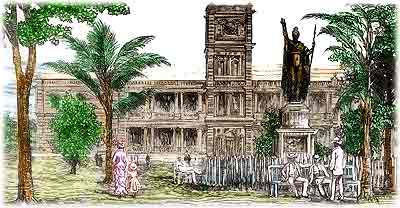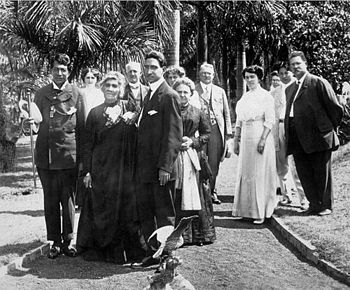Hawaiian Annexation
INDIGENOUS RIGHTS, HISTORY, ANGLO AMERICA, ASIA--PACIFIC, 4 Feb 2019
U.S. History | The Independence Hall Association – TRANSCEND Media Service

Ali’iolani Hale, completed in 1874, was the home of the Hawaiian Legislature in the days before annexation. Judiciary History Center
By the time the United States got serious about looking beyond its own borders to conquer new lands much of the world had already been claimed. Only a few distant territories in Africa and Asia and remote islands in the Pacific remained free from imperial grasp. Hawaii was one such plum. Led by a hereditary monarch, the inhabitants of the kingdom prevailed as an independent state. American expansionists looked with greed on the strategically located islands and waited patiently to plan their move.
Foothold in Hawaii
Interest in Hawaii began in America as early as the 1820s, when New England missionaries tried in earnest to spread their faith. Since the 1840s, keeping European powers out of Hawaii became a principal foreign policy goal. Americans acquired a true foothold in Hawaii as a result of the sugar trade. The United States government provided generous terms to Hawaiian sugar growers, and after the Civil War, profits began to swell. A turning point in U.S.-Hawaiian relations occurred in 1890, when Congress approved the McKinley Tariff, which raised import rates on foreign sugar. Hawaiian sugar planters were now being undersold in the American market, and as a result, a depression swept the islands. The sugar growers, mostly white Americans, knew that if Hawaii were to be annexed by the United States, the tariff problem would naturally disappear. At the same time, the Hawaiian throne was passed to Queen Liliuokalani, who determined that the root of Hawaii’s problems was foreign interference. A great showdown was about to unfold.
Annexing Hawaii
In January 1893, the planters staged an uprising to overthrow the Queen. At the same time, they appealed to the United States armed forces for protection. Without Presidential approval, marines stormed the islands, and the American minister to the islands raised the stars and stripes in Honolulu. The Queen was forced to abdicate, and the matter was left for Washington politicians to settle. By this time, Grover Cleveland had been inaugurated President. Cleveland was an outspoken anti-imperialist and thought Americans had acted shamefully in Hawaii. He withdrew the annexation treaty from the Senate and ordered an investigation into potential wrongdoings. Cleveland aimed to restore Liliuokalani to her throne, but American public sentiment strongly favored annexation.
The matter was prolonged until after Cleveland left office. When war broke out with Spain in 1898, the military significance of Hawaiian naval bases as a way station to the Spanish Philippines outweighed all other considerations. President William McKinley signed a joint resolution annexing the islands, much like the manner in which Texas joined the Union in 1845. Hawaii remained a territory until granted statehood as the fiftieth state in 1959.
__________________________________________________
Copyright ©2008-2018 ushistory.org, owned by the Independence Hall Association in Philadelphia, founded 1942.
This work by The Independence Hall Association is licensed under a Creative Commons Attribution 4.0 International License.
Go to Original – ushistory.org
DISCLAIMER: The statements, views and opinions expressed in pieces republished here are solely those of the authors and do not necessarily represent those of TMS. In accordance with title 17 U.S.C. section 107, this material is distributed without profit to those who have expressed a prior interest in receiving the included information for research and educational purposes. TMS has no affiliation whatsoever with the originator of this article nor is TMS endorsed or sponsored by the originator. “GO TO ORIGINAL” links are provided as a convenience to our readers and allow for verification of authenticity. However, as originating pages are often updated by their originating host sites, the versions posted may not match the versions our readers view when clicking the “GO TO ORIGINAL” links. This site contains copyrighted material the use of which has not always been specifically authorized by the copyright owner. We are making such material available in our efforts to advance understanding of environmental, political, human rights, economic, democracy, scientific, and social justice issues, etc. We believe this constitutes a ‘fair use’ of any such copyrighted material as provided for in section 107 of the US Copyright Law. In accordance with Title 17 U.S.C. Section 107, the material on this site is distributed without profit to those who have expressed a prior interest in receiving the included information for research and educational purposes. For more information go to: http://www.law.cornell.edu/uscode/17/107.shtml. If you wish to use copyrighted material from this site for purposes of your own that go beyond ‘fair use’, you must obtain permission from the copyright owner.
Read more
Click here to go to the current weekly digest or pick another article:
INDIGENOUS RIGHTS:
- We Must Purge Genocide from the Marrow of Our Bones
- The Day of the World’s Indigenous Peoples
- ‘A World without Borders’: Revolutionary Love and Solidarity for Palestine
HISTORY:
- History of US-Iran Relations: From the 1953 Regime Change to Trump Strikes
- Digging Up the Roots of Human Culture
- The Geopolitics of Southeast Europe and the Importance of the Regional Geostrategic Position at the Turn of the 20th Century
ANGLO AMERICA:
- Washington Green-Lights $30M for Gaza Aid Scheme Tied to Mass Killings of Palestinians
- War with Iran: We Are Opening Pandora's Box
- Trump’s Useful Idiots
ASIA--PACIFIC:
